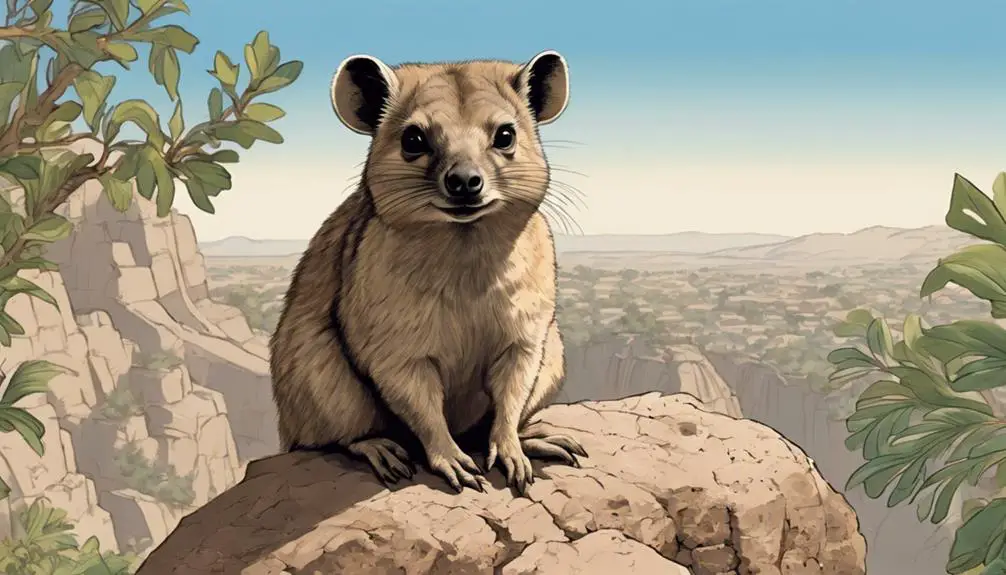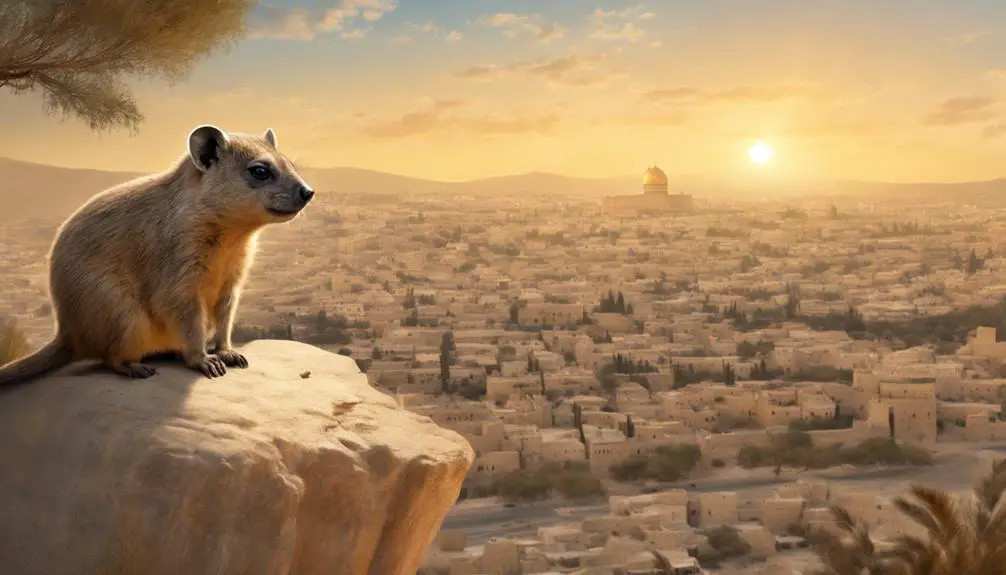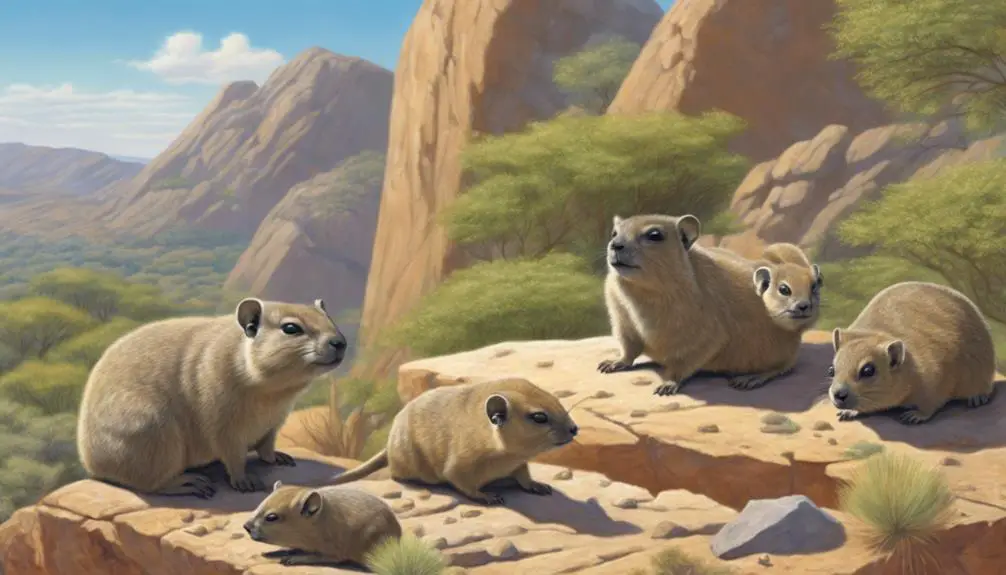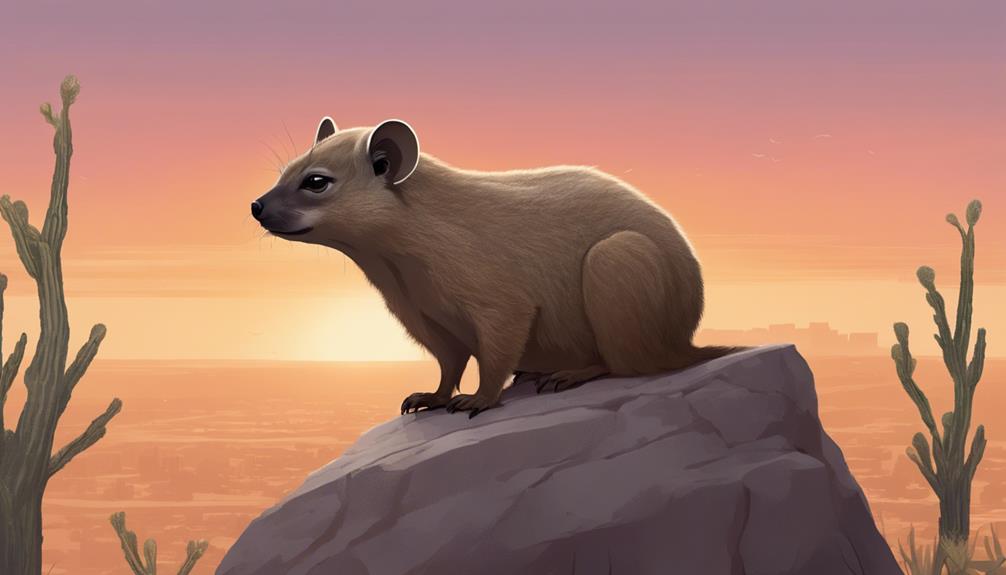Meet the hyrax, a biblical enigma nestled in ancient texts, whose significance in scripture might just challenge your perceptions.

What Is a Hyrax in the Bible
In your quest through the biblical zoo, you've likely skipped over the hyrax, a creature that seems to have mistakenly wandered into scripture from a children's book. But don't let its obscurity fool you; this small mammal holds a unique place in biblical texts, nestled among the clean and unclean animals.
Its mention in Leviticus and Deuteronomy isn't just for show. Understanding the hyrax's role and symbolism could shed light on ancient dietary laws and cultural perceptions of animals.
So, why not embark on a journey to uncover the mystery behind this seemingly insignificant creature? The insights gained might surprise you.
Key Takeaways
- The Hebrew word 'shaphan', traditionally translated as 'hyrax', appears in biblical texts with cultural and religious significance.
- In the Bible, the hyrax symbolizes wisdom and discernment, notably in its ability to build secure homes.
- Biblical references to the hyrax contribute to discussions on purity, community identity, and the ethical treatment of nature.
- Modern interpretations of the hyrax in the Bible highlight its ecological role and serve as a metaphor for survival and resilience.
Defining the Hyrax

Despite their small size and unassuming appearance, hyraxes play a significant role in various ecosystems and possess a unique biological classification that sets them apart from other small mammals. You'll find their physiology particularly fascinating, as it reveals a closer genetic relationship to elephants and manatees than to the rodents they superficially resemble. This connection is evident in their skeletal structure, notably in the shape of their feet and the tusks that emerge from their incisors, mirroring the larger tusks of their elephant cousins.
Their dietary habits further underscore their distinctiveness in the animal kingdom. Hyraxes predominantly consume a diet of grass, fruits, and leaves, showcasing a versatile feeding strategy that allows them to thrive in a range of habitats from dense forests to rocky terrains. Unlike many small mammals, hyraxes have a complex, multi-chambered stomach that efficiently breaks down fibrous plant materials, a feature that parallels the digestive systems of many herbivorous megafauna. This adaptation not only supports their dietary needs but also impacts the ecosystems they inhabit, as they play a crucial role in seed dispersion and vegetation management.
Biblical References Explained
The hyrax, though often overlooked in modern discourse, holds a notable presence in biblical texts, inviting a deeper exploration of its symbolic and literal significance within these ancient narratives. As you delve into the references, you'll encounter translation challenges that have long puzzled scholars. The Hebrew word 'shaphan,' traditionally translated as 'hyrax,' appears in various contexts, suggesting a creature known for its cunning and modesty. However, the exact identification has stirred debate due to the nuances of ancient texts and the evolution of language over centuries.
Analyzing these references, it's clear that the hyrax was more than just a mere animal to the ancient writers; it was imbued with cultural and religious meanings. The dietary laws in Leviticus, which mention the hyrax as unclean, reflect not only on the dietary habits but also on broader themes of purity and community identity. Proverbs highlights the hyrax's wisdom in building its home in the rocks, an analogy for strength and security derived from wise choices.
Understanding these biblical passages requires a careful consideration of the historical and cultural context, highlighting how translation challenges can illuminate or obscure the text's original meaning. The hyrax, thus, serves as a fascinating lens through which to explore the intricacies of biblical interpretation and the rich tapestry of ancient life.
Natural Habitat and Behavior

Understanding the hyrax's significance in biblical texts enriches our knowledge, yet examining its natural habitat and behavior offers a different perspective on why it held such meaning for ancient communities. Hyraxes, also known as rock rabbits or dassies, inhabit rocky terrains and arid landscapes across Africa and the Middle East. Their behavior and diet specifics reflect a remarkable adaptation to these environments, balancing between foraging efficiency and the constant vigilance required to evade predation threats.
- Rocky Terrain Mastery: Hyraxes excel in navigating the steep cliffs and boulders of their habitat, using well-developed pads on their feet for grip.
- Social Structures: They live in complex social groups, which play a crucial role in predator detection and communal warmth during rest periods.
- Diet Specifics: Their diet primarily consists of grasses, leaves, and fruit, showing a remarkable ability to subsist on the sparse vegetation available in their arid environments.
- Predation Threats: Eagles, leopards, and snakes are key predators, shaping the hyrax's behavior towards caution and their ability to hide in rock crevices.
- Sun Bathing Rituals: Hyraxes often bask in the sun to regulate their body temperature, a behavior critical for their survival in fluctuating temperatures.
This lifestyle, balanced on the edge of survival, showcases the hyrax's intriguing place in the natural world and hints at why they captivated the imagination of ancient peoples.
Cultural Significance
Exploring the hyrax's cultural significance reveals its profound impact on ancient societies, particularly within biblical narratives, where it emerges as a creature of symbolic and practical importance. This small, seemingly inconsequential animal carries weight in mythological interpretations and is steeped in ancient symbolism, reflecting the values and beliefs of the time.
In biblical texts, the hyrax is mentioned in the context of dietary laws and purity codes, symbolizing discernment and separation between the sacred and the profane. This symbolism extends beyond religious mandates, tapping into broader mythological interpretations that view the hyrax as a mediator between realms or a symbol of wisdom and adaptation.
The ancient symbolism associated with the hyrax underscores its significance in cultural narratives, where its characteristics and behaviors serve as metaphors for human virtues and vices. Through scholarly analysis, it's clear that the hyrax's portrayal in ancient texts isn't merely descriptive but deeply emblematic, reflecting the complex interplay between humanity and the natural world. This creature's presence in sacred scripts and mythological stories thus offers valuable insights into how ancient societies understood and related to the animal kingdom.
Modern Interpretations and Insights

Modern scholars' interpretation of the hyrax in biblical texts reveals a nuanced understanding of its symbolic significance, shedding light on ancient perspectives and how they evolve in contemporary discourse. You'll find that this small creature, often overlooked, carries weighty ecological symbolism and theological metaphors that resonate with today's environmental and spiritual conversations.
- Ecological Symbolism: The hyrax's adaptation to diverse habitats underscores themes of survival and resilience, reflecting on the broader ecological messages woven into the biblical narrative.
- Theological Metaphors: Scholars highlight how the hyrax, considered unclean, opens discussions on purity, community, and the boundaries of inclusion and exclusion in ancient religious practices.
- Cultural Resonance: The animal's mention in scripture provides a lens through which to explore the intertwining of daily life and sacred texts in ancient societies.
- Interpretative Evolution: Modern interpretations often emphasize the ethical implications of our relationship with nature, inspired by such biblical references.
- Symbolic Connections: The hyrax serves as a bridge connecting historical religious teachings with contemporary issues, encouraging a reevaluation of our place within the natural world.
Through these lenses, you're invited to appreciate the depth of biblical references to the hyrax, enriching your understanding of its significance in both ancient texts and modern interpretations.
Frequently Asked Questions
How Has the Hyrax Been Depicted in Ancient Art and Literature Outside of the Biblical Context?
In ancient art and literature, the hyrax often emerges in mythology and sculptures, reflecting its enigmatic presence in human culture. These depictions go beyond mere animal representation; they delve into symbolic realms, where the hyrax embodies various attributes or moral lessons.
Ancient sculptures, particularly, offer a visual testament to the hyrax's significance, highlighting its role in storytelling and myth-making. This multifaceted portrayal underscores the creature's enduring legacy in cultural narratives.
Are There Any Specific Dietary Restrictions Related to the Hyrax in Other Religious or Cultural Practices?
Ever wondered about the intriguing world of hyrax cuisine and its cultural symbolism?
You'll find that specific dietary restrictions related to the hyrax in other religious or cultural practices are quite rare. Unlike the clear guidelines found in some traditions, the hyrax's role in diet and symbolism is less pronounced, subtly weaving into the fabric of various cultures without the fanfare or strict taboos you might expect.
It's a fascinating niche in the broader tapestry of culinary history.
What Are the Scientific Challenges in Studying Hyraxes, and How Have Researchers Overcome Them?
You're diving into the complexities of studying hyraxes, focusing on their climate adaptation and vocal communication. Scientists face challenges like their elusive nature and diverse habitats, making data collection tough.
Yet, they've innovated by using remote sensors to track climate adaptation and advanced recording for vocal patterns. This blend of tech and fieldwork has peeled back layers on hyrax behavior, offering insights into how these creatures thrive across varied environments.
How Do Contemporary Zoos and Wildlife Conservations Around the World Care for and Maintain Hyrax Populations?
You'll find that contemporary zoos and wildlife conservations meticulously care for hyraxes by focusing on two critical aspects: hyrax vocalizations and enclosure design.
They analyze hyrax vocalizations to understand their needs and social structures, ensuring their emotional well-being.
Meanwhile, enclosure design is tailored to mimic natural habitats, promoting physical health and encouraging natural behaviors.
This dual approach ensures hyraxes thrive, reflecting a scholarly commitment to both their conservation and well-being.
What Role Does the Hyrax Play in the Ecosystems They Inhabit, and What Impact Does Their Presence Have on Biodiversity?
In ecosystems, hyraxes play crucial roles. They're significant for biodiversity, acting as prey for predators and controlling vegetation.
Their unique vocalizations contribute to the soundscape, influencing communication patterns among species.
They face predation threats, which impact their populations and, in turn, those of their predators.
This balance affects the ecosystem's overall health.
Understanding their role offers insights into ecosystem dynamics and the importance of preserving such interconnected relationships.
Conclusion
In conclusion, your exploration of the hyrax in biblical texts reveals a creature deeply interwoven with ancient cultural and religious narratives.
Interestingly, despite its small size, the hyrax shares a staggering 90% of its genome with the elephant, showcasing the complexity of creation narratives and their interpretations.
This statistic enriches our understanding of the hyrax's significance, both in its natural habitat and its symbolic presence across various contexts, underscoring the nuanced relationship between scripture and the natural world.



Sign up